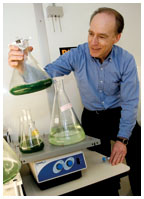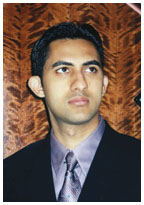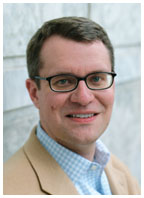
June 11, 2008: Notebook
Coalition: Explore new ideas to cut high-risk drinking
BREAKING GROUND-Chemistry
From green algae to green fuel
Salmonella outbreak tied to Frist eatery
Longtime professors earn emeritus status
The nexus of faith and diplomacy
Coordinator of Hindu life is selected
(Imagezoo/Getty Images) |
Coalition: Explore new ideas to cut high-risk drinking
High-risk drinking is on the rise at American colleges, and Princeton must engage students and partner with campus groups to address the problem, according to a plan released May 13 by the Alcohol Coalition Committee, a University-appointed group of students, faculty, and staff.
The committee outlined three broad recommendations: to create a standing committee to propose and review alcohol initiatives; to examine new ideas in areas that include alcohol education, communication, and campus programs and events; and to use data to better understand the scope of the problem and measure progress.
The prominence of eating clubs and other group affiliations creates a demanding social scene for Princeton undergraduates, the report said, and “students regularly report consuming alcohol because of strong pressures to succeed socially.” While the report did not detail the prevalence of high-risk drinking on campus, Princeton stands “largely in line with national trends,” according to Sanjeev Kulkarni, a professor of electrical engineering who co-chaired the committee with Agatha Offorjebe ’09. Committee members reviewed information about alcohol-related admissions to University Health Services, Public Safety calls, and University disciplinary actions.
The committee cited the common practice of “pre-gaming” — consuming large amounts of alcohol quickly to prepare for a night out on “the Street” — as one example of high-risk drinking and suggested that eating clubs consider adding alcohol-free events “to combat the impression that alcohol is a prerequisite to socializing in the clubs.”
Among the dozens of ideas for consideration listed in the plan were several intended to promote responsible drinking, including the creation of a campus pub, a ban on hard alcohol in dormitories, a repeal of the 17-year-old ban on kegs in dorms, and the addition of a party-registration system, in which students of legal drinking age could host parties in their dorm rooms with underage students in attendance, as long as the underage students abstained from drinking.
Party registration is one initiative from the plan that already is moving forward. The University also plans to re-evaluate the alcohol education course that freshmen complete during orientation and add a section about alcohol use and the undergraduate experience to the exit survey that seniors complete each May.
Kulkarni, who also serves as the master of Butler College, said that student suggestions played a significant role in the committee’s plan. Undergraduates made up half of the committee and about half of the more than 300 attendees at three workshops held in February. But initially, not all students recognized a need to re-examine drinking on campus, Offorjebe said.
“When I first started meeting with students, [people asked] ‘Is high-risk drinking even an issue on campus? Why are we having this discussion?’ ” she said. “From the student perspective, it shifted from being focused on high-risk drinking to the drinking culture in general on campus. ... Once I started talking about it from a health and well-being standpoint, no students disagreed with me. It is very much a health issue.”
Josh Weinstein ’09, president of the Undergraduate Student Government, said the plan touched on two USG priorities: increasing funding for social events and improving student interactions with Public Safety officers.
The Alcohol Coalition Committee was formed in December 2007, shortly after the University caused a minor stir among undergraduates when it released new Residential College Adviser guidelines that aimed to reduce heavy drinking in residence halls. (The guidelines have since been revised.) The complete Alcohol Coalition Committee
Strategic Plan is available online at http://www.princeton.edu/reports/alcohol-20080509/.![]()
By B.T.

Professor Charles Dismukes examines bacteria and algae that could produce green fuels or fuel precursors. (Beverly Schaefer) |
BREAKING
GROUND-Chemistry
From
green algae to green fuel
Using cleaner-burning alternative fuels like hydrogen or biofuels to replace oil and gas has become an attractive idea for curbing carbon-dioxide emissions. But to supply those alternatives, researchers have to find a way to produce the fuels needed to replace fossil fuels without burning fossil fuels in the process.
Chemistry professor Charles Dismukes is exploring two ways to clear that hurdle. One employs algae and bacteria to make energy products such as hydrogen, biomass, or other fuel precursors. The other aims to use solar energy and a biologically inspired catalyst to drive hydrogen production from water.
In the first project, Dismukes’ group leads a consortium of seven laboratories to study a range of interesting organisms. The “bio-prospectors” are exploring some of the more than 4,500 classified species of cyanobacteria — single-celled bacteria that live in a variety of ecological niches — in hopes of finding potential fuel producers.
One of the most promising candidates that Dismukes has examined is Arthrospira, a type of green algae that lives in volcanic lakes in the Rift Valley of East Africa. Arthrospira, Dismukes’ lab has found, is “the fastest water-splitting enzyme on the
planet” and a prolific hydrogen producer. It also grows naturally in an extremely harsh environment where the pH level often climbs to 10 or 11, so it has a remarkable resistance to contaminants — a valuable trait if it were to be developed to produce biomass or hydrogen in large quantities.
The other avenue to hydrogen production that Dismukes is pursuing uses solar power and a synthesized, manganese-based catalyst to split water into hydrogen and oxygen. The technology eventually could be deployed on a sandwichlike photovoltaic cell coated with the water-splitting catalyst on one side and a proton-reducing catalyst on the other. The bio-inspired catalyst was designed to be structurally similar to the manganese core of a natural enzyme found in all photosynthetic water-splitting organisms.
The bio-inspired concept is powerful, according to Gerry Swiegers of Australia’s Commonwealth Scientific and Industrial Research Organization, one of Dismukes’ collaborators. “At this stage, it’s not where we want to be yet — it’s got to get quite a lot more efficient — but the principle is established,” Swiegers says.
For Dismukes, both projects contain exciting possibilities. He began working on energy research about six years ago, hoping to address global warming by applying some of what he’d learned in decades of studying the fundamentals of photosynthesis. In the process, he says, he has found a community of scientists committed to finding energy solutions.
“There’s no question that the graduate students and the
undergraduates we’re working with are absolutely passionate about
working on renewable energy systems,” Dismukes says. “They’re
willing to sacrifice lots of personal time to spend more time in the lab
and modify their academic programs so that they’re taking courses
that will reinforce that goal. That’s wonderful to see that kind
of devotion.” ![]()
By B.T.

Salmonella outbreak tied to Frist eatery
A salmonella outbreak on campus in late April and early May most likely resulted from food contamination by a Frist Campus Center worker who was ill, a state health investigation found.
University spokeswoman Cass Cliatt ’96 said there were 28 confirmed salmonella cases — 20 students and eight University staff members, including three food handlers. Another 42 individuals were termed “probable” cases, according to the state.
Several food items served at a Mexican food station in the Frist Gallery were linked to those who contracted the illness, said Mary Glenshaw, an Epidemic Intelligence Service officer with the CDC who is working with the state health department and who headed the investigation.
Those who developed gastrointestinal illness ate at Frist between April 18 and May 2, Glenshaw said, with symptoms — including diarrhea, abdominal cramps, fever, nausea, and/or vomiting — showing up from April 20 to May 7. She said three individuals who became sick received hospital emergency-room treatment, while eight students spent a night at McCosh Health Center because they had become dehydrated.
On May 3 the University shut down the Mexican and salad-bar food areas at Frist, two of several food stations that are part of the Frist Gallery. The two food stations reopened May 19.
Dining Services, which operates the Frist eating areas, is putting into effect new training that emphasizes the importance of hand-washing and sanitation, Cliatt said.
Glenshaw said the eateries at Frist — the most frequently used
dining facility on campus — were inspected multiple times during
the investigation and passed each time with only “very minor”
violations. ![]()
By W.R.O.

Longtime professors earn emeritus status
Thirteen professors with a total of 371 years of teaching at Princeton have transferred to emeritus status, including two — Robert C. Darnton and John Suppe — who retired in 2007.
PETER R. GRANT, the Class of 1877 Professor of Zoology, is best known for collaborating with his wife, Rosemary, on the exploration of evolution by natural selection in a 35-year study of Charles Darwin’s finches on the Galapagos Islands. The findings showed that small-scale evolution in beak size and shape can occur in less than a year, far faster than previously had been believed for long-lived animals like birds. The Grants came to Princeton in 1985.
Molecular biology professor JOHN J. HOPFIELD, the Howard A. Prior Professor in the Life Sciences, has been recognized for his research in physics, chemistry, and biology. He received the Buckley Prize for research on emission and absorption of light by semiconductors; the work led to the founding of the semiconductor light-emitting diodes (LEDs) industry. In chemistry, Hopfield offered an explanation of the role of cooperativity in the binding of oxygen atoms to hemoglobin. In biology, his contributions include the invention of an associative neural network that demonstrates the wide difference in computing between the human brain and the computer.
During English professor WILLIAM L. HOWARTH’s 42 years at Princeton, he taught courses on intellectual history and textual criticism, added more than 50 new courses, pioneered humanities computing, supervised 100 dissertations and 256 senior theses, and led 51 alumni programs. He is an authority on Henry D. Thoreau, and he became the youngest-ever editor-in-chief of an NEH-sponsored project, the 25-volume writings of Thoreau. His later scholarship was highlighted by autobiography and literary journalism, and he introduced the University’s first courses on literary geography and environmental history, among others.
HISASHI KOBAYASHL *67 came to Princeton in 1986 as dean of the School of Engineering and Applied Science and the Sherman Fairchild University Professor. During his five years as dean, the number of permanent faculty in the school grew by 29 percent. After a year in Tokyo, he returned to Princeton as a professor of electrical engineering. Kobayashi has been honored for his invention of a high-density digital recording scheme known as PRML.
JOSEPH J. KOHN *56, a professor of mathematics since 1968, is known for his pioneering work on the interaction between particle differential equations and functions of several complex variables. He was chairman of the mathematics department several times, and he held the Henry Burchard Fine research chair from 2002 to 2003.
RALPH LERNER, the George Dutton ’27 Professor of Architecture, joined the faculty in 1984. While serving as dean of the School of Architecture from 1989-2002, he recruited significant new design faculty, strengthened the Ph.D. program in the history and theory of architecture, and consolidated the school’s emphasis on urban issues.
East Asian studies professor PERRY LINK JR. is noted as a scholar of modern Chinese literature and an authority on contemporary Chinese politics and intellectual life. After teaching at Princeton from 1973 to 1976, Link spent 13 years at UCLA before returning to the University in 1989. He taught first-year Chinese for two decades; with his colleague C.P. Chou, he founded and managed Princeton-in-Beijing, a total-immersion summer program. Several years after helping an outspoken scientist escape to the United States during the Tiananmen protests in 1989, Link was banned from China. In 2001, along with Andrew Nathan, Link obtained a set of secret government documents and translated and edited them as The Tiananmen Papers.
GUUST NOLET, the George J. Magee Professor of Geosciences and Geological Engineering and a faculty member since 1991, was a pioneer in seismic tomography — the imaging of the deep Earth — and designed the first portable digital seismic array for field studies of the Earth’s interior. He discovered thermal plumes deep in the Earth’s mantle, but may be best known to Princeton students for teaching the large GEO 210 course (“Earthquakes, Volcanoes, and Other Hazards”) nicknamed “shake and bake.”
Chemistry professor GIACINTO SCOLES came to Princeton in 1986 as the Donner Professor of Science. Much of his research focused on intermolecular forces and chemical-reaction dynamics. Scoles played an important role in the establishment of the Princeton Materials Institute, and he edited Atomic and Molecular Beam Methods.
ABRAHAM L. UDOVITCH, the Khedouri A. Zilkha Professor of Jewish Civilization in the Near East, joined the faculty in 1967 and served as chairman of the Department of Near Eastern Studies for 18 years. A scholar of the economic life of the medieval Near East and North Africa, Udovitch also has played an active role in attempts to end the Israeli-Palestinian conflict.
BASTIAAN C. VAN FRAASSEN, the McCosh Professor of Philosophy, came to Princeton in 1981. Van Fraassen is best known for writings on the philosophy of science in support of an unorthodox position that he called “constructive empiricism.” A colorful member of the department, he hosted legendary parties, inspiring the formation of a band that named itself the Van Fraassens. He also has published short stories and been an enthusiastic rock climber, and recently took up the trapeze.
ROBERT C. DARNTON, a history professor from 1968 until his departure last year to become the director of Harvard’s University Library, is a noted historian of publishing, books, and their readers. A crime reporter for The New York Times before he entered academe, Darnton believed that a historian should be a good storyteller and be accessible to a wide audience. A past president of the American Historical Association, he was a winner of the Guggenheim and MacArthur Prize fellowships.
JOHN SUPPE was the Blair Professor of Geology from
1988 to 2007, when he left Princeton to take a position at the National
Taiwan University. Suppe, who joined the faculty in 1971, conducted research
in Taiwan in 1978 that has applications in assessing earthquake hazards
and in petroleum exploration and development. As chairman of the department,
Suppe encouraged the application of microbiology and molecular biology
to biologically mediated chemical processes in the Earth, such as global
warming. ![]()

(Steven Veach) |
Bits at risk
Putting a laptop computer on sleep mode
does not guarantee that its data will remain secure, according to a study
from Princeton’s Center for Information and Technology Policy. Researchers
devised a way to sidestep disk encryption systems by lifting information
from the computer’s random access memory (RAM), where data is stored
while it is being used. A computer’s RAM retains its contents for
a brief time after power is shut off (and even longer if the memory chip
is removed and cooled). With just a few minutes of physical access to
a computer, the Princeton team was able to make a near-perfect copy of
its RAM, search the data for encryption keys, and access protected information.
After exploring possible defenses against the memory attacks, the researchers
concluded that there is “no easy remedy.” More details and
a video explaining the research are available at http://citp.princeton.edu/memory/.
![]()

From left, Ali Hamoudi GS, co-directors Paul Raushenbush and Wolfgang Danspeckgruber, and Celene Lizzio ’08 at a weekly seminar of a new program on religion and diplomacy. (Frank Wojciechowski) |
The nexus of faith and diplomacy
Celene Lizzio ’08 spent last summer in Egypt, setting up a small shop in Cairo to create “Peace-Shirts” — T-shirts that carried the message, “Islam means peace.” One of 100 student-organized Projects for Peace funded by Kathryn W. Davis, widow of the late Shelby C. Davis ’30, Lizzio’s project sought to provide jobs and to spark a dialogue about a peaceful society and interfaith tolerance.
Back at Princeton last fall for the start of her senior year, Lizzio heard about a new University program with a similar theme: the Program on Religion, Diplomacy, and International Relations (PORDIR). Convinced that some opportunities “have your name on them,” she returned her application within 24 hours and was selected as one of 12 fellows who launched the program.
The program is part of the Liechtenstein Institute on Self-Determination and is co-directed by Wolfgang Danspreckgruber, institute director and lecturer in public and international affairs, and Paul Raushenbush, associate dean of religious life.
“Part of what it means to be an educated citizen of the world is to understand the ways in which religion factors into both personal lives and public arenas,” Raushenbush said. “PORDIR wants to solicit a breadth of perspectives and provide a foundation for a better understanding of the nexus of religious practice and the practice of international relations.”
While the program does not provide academic credit, in practice it is similar to a graduate seminar, Danspeckgruber said. The four undergraduate and eight graduate fellows each produced an academic journal-length article for publication in an edited volume and presented a paper at the program’s weekly luncheon seminars. The program also offered a public lecture series, and it culminates with a conference in Vienna July 10–12 in which the students will present their papers to an audience of about 50 academics, religious and public officials, and other students.
The program leaders decided not to focus the students’ research on any single religion or part of the world, but to let them select a topic based on their academic or personal interest. Danspeckgruber said the students’ work demonstrates an intense emotional curiosity. “You feel a real personal involvement,” he said.
Jon Gandomi, who is studying international relations in a master’s program at the Woodrow Wilson School, is a member of the Baha’i faith, and his research talked about using Baha’i principles in conflict resolution. Gandomi, who said he hopes to be part of U.N. efforts for post-conflict reconstruction in Afghanistan, said that most of his courses didn’t emphasize how religion intersects with global issues. That wasn’t the case during a PORDIR luncheon midway through the spring term, however, as Gandomi fielded questions about how Bahai’s have tried to influence state policy and international law.
The fellows bring a wide range of religious, national, and work backgrounds, including international-relations experience in a number of countries. The diversity contributes to “a space where people can ask critical questions in a safe environment,” Raushenbush said.
Lizzio, a Near Eastern studies major who is heading to Harvard Divinity
School in the fall, agreed. A convert to Islam in Egypt who married an
Egyptian man during a pause in her Princeton studies, she said, “It’s
nice to be able to say, what do I personally bring to this discussion?”
![]()
By W.R.O.

(Courtesy Vineet Chander) |
Coordinator of Hindu life is selected
Vineet Chander, who has served as Hindu chaplain at George Washington University and at Rutgers University, has been hired as Princeton’s first coordinator of Hindu life.
Alison Boden, dean of religious life, said that Chander will begin a one-year term in the part-time position in August. While he will perform chaplaincy work “to a certain extent,” she said, he is being hired as a University employee in the Office of Religious Life and not as a chaplain.
Chander’s responsibilities will include mentoring Hindu students, helping to create programming, developing contacts with the greater Hindu community in the area, and connecting with Hindu alumni, Boden said.
Chander described the new position — a pilot program — as “a pioneering opportunity.” He said he hopes to help students and faculty who are practicing Hindus to “appreciate and grow in their faith” while providing connections with other faiths and traditions.
He praised the activities of Princeton Hindu Satsangam, a student organization for those interested in Hinduism, and said his goal is to help students take their work “to the next level.”
Chander is an American-born Hindu priest who graduated from George Washington University Law School and spent a year as a New York assistant district attorney. He is a religious-communications consultant with the International Society for Krishna Consciousness, a devotional tradition within the family of Hindu faiths.
As of mid-May, the University was continuing to interview candidates
for the position of coordinator of Muslim life. ![]()
By W.R.O.

International applications jumped 10 percent as the GRADUATE SCHOOL’s overall application pool increased 5.2 percent this year. Of the 9,238 applicants, 1,202 — or 13 percent — were offered admission. Acceptances totaled 608, a yield of 51 percent. Applications were received from 61 foreign countries; the largest number of admitted students were from China, India, Korea, and Canada. Both offers (76) and acceptances (48) among African-American, Latino/Hispanic, and American Indian students were the highest of the past five years, reflecting stepped-up recruiting efforts. The number of offers (184) and acceptances (70) for women in science and engineering both fell below recent years. Total fall enrollment is expected to be about 2,180, up from 2,030 last year. About 265 students are expected to hold Dissertation Completion Enrollment status.
Peter Silver (Pryde Brown, Courtesy of Peter Silver |
Peter Silver, an assistant professor of history, was awarded the BANCROFT PRIZE for his first book, Our Savage Neighbors: How Indian War Transformed Early America (W.W. Norton, 2007). Silver is one of three honorees this year. The Bancroft Prize recognizes “books of exceptional merit in the fields of American history, biography, and diplomacy.”
After the May 1 deadline for students to accept or decline their offers of undergraduate admission, the University admitted 86 students from the WAIT LIST, and that number was expected to rise in what Dean of Admission Janet Rapelye termed a “rolling process” that could last until end of June. Last year Princeton offered admission to 47 students on the wait list; 37 accepted the offer.
This has been a year of transition and increased uncertainty, in part because of the end of early admissions at Princeton and Harvard. Princeton’s yield — those who choose to enroll compared to the total number accepted — is expected to decline from 67.8 percent last year to “close to 60 percent” this year, Rapelye said. She said the Class of 2012 will be “slightly stronger,” however, as measured by SAT scores. Students planning to enroll are evenly split between men and women and are “as diverse as last year’s class,” she said. Women account for a record 48 percent of incoming engineering students.
HUGH PRICE, former president of the National Urban
League and a senior fellow at the Brookings Institution, will begin a
five-year appointment to the faculty of the Woodrow Wilson School July
1. Serving as the John L. Weinberg/Goldman Sachs Visiting Professor of
Public and International Affairs, Price will teach two courses this fall
— an undergraduate policy task force on childhood obesity and a
graduate seminar that will examine whether and how foundations can serve
as agents of change. ![]()

(Frank Wojciechowski) |
Ryan Dowd ’11 flashes a big grin after taking a pie in the face
April 26 to benefit the Leukemia and Lymphoma Society during Communiversity,
Princeton’s annual town-gown celebration, which drew an estimated
30,000 people. ![]()





 Vineet
Chander
Vineet
Chander 
